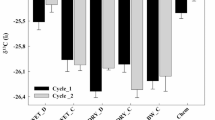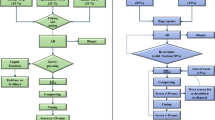Abstract
Purpose
Organic waste (OW), such as anaerobic digestates and compost, can provide nitrogen (N) and valuable crop available phosphorous (P) and is a potential alternative to chemical P fertilizers, which is a non-renewable resource. However, little is known about the short- to medium-term P supply capacity of OW within the framework of optimal soil organic carbon management.
Methods
In this study, four products were investigated: a sewage sludge digestate (D1) and biowaste digestate (D2), in addition to their respective composts (C1 and C2). These products were compared at 170 kg N ha−1 along with a chemical fertilizer (Chem) and digestate from animal manure (DM) in two successive tests on potted ryegrass (84 + 84 days), without (N −) and with (N +) mineral N supply (170 kg N ha−1). Their agronomic performance and apparent bioavailable P (ABP mg pot−1) were assessed. In addition, the variation in the total organic carbon (TOC), labile carbon (CL), and carbon management index (CMI) was monitored in potting soil at the end of the two growth cycles.
Results
The pot test showed that after 84 days, Chem mostly exploited its ABP (95%), similar to DM, resulting in a low-P inheritance over 168 days, while the compared products (D1; C1; D2; C2) ensured long-lasting P release. CL was more sensitive than Corg to changes occurring during the test, thus proving that biowaste products, especially compost (C2), gained the best CMI.
Conclusions
This promising approach may provide comprehensive insight into rational P fertilization via OW soil distribution and can provide important information on its effect on overall soil carbon management, a currently notable issue, especially in the Mediterranean region.





Similar content being viewed by others
References
Akbar S, Ahmed S, Khan S, Badshah M (2021). Anaerobic Digestate: a sustainable source of bio-fertilizer. In sustainable intensification for agroecosystem services and management ( 493–542). Springer, Singapore. https://doi.org/10.1007/978-981-16-3207-5
Alburquerque JA, De la Fuente C, Campoy M, Carrasco L, Nájera I, Baixauli C, Bernal MP (2012) Agricultural use of digestate for horticultural crop production and improvement of soil properties. Eur J Agron 43:119–128. https://doi.org/10.1016/j.eja.2012.06.001
Bachmann S, Wentzel S, Eichler-Löbermann B (2011) Codigested dairy slurry as a phosphorus and nitrogen source for Zea mays L. and Amaranthus cruentus L. J Plant Nutr Soil Sci 174:908–915. https://doi.org/10.1002/jpln.201000383
Banerjee MR, Burton DL, Depoe S (1997) Impact of sewage sludge application on soil biological characteristics. Agric Ecosys Environ 66:241–249. https://doi.org/10.1016/S0167-8809(97)00129-1
Blair GJ, Lefroy RD, Lisle L (1995) Soil carbon fractions based on their degree of oxidation, and the development of a carbon management index for agricultural systems. Aust J Agr Res 46:1459–1466. https://doi.org/10.1071/AR9951459
Chen HL, Zhou JM, **ao BH (2010) Characterization of dissolved organic matter derived from rice straw at different stages of decay. J Soils Sediments 10:915–922. https://doi.org/10.1007/s11368-010-0210-x
Cristina G, Camelin E, Pugliese M, Tommasi T, Fino D (2019) Evaluation of anaerobic digestates from sewage sludge as a potential solution for improvement of soil fertility. Waste Manage 99:122–134. https://doi.org/10.1016/j.wasman.2019.08.018
De Bona FD, Bayer C, Dieckow J, Bergamaschi H (2008) Soil quality assessed by carbon management index in a subtropical Acrisol subjected to tillage systems and irrigation. Soil Res 46:469–475. https://doi.org/10.1071/SR08018
de Brogniez D, Ballabio C, Stevens A, Jones RJA, Montanarella L, van Wesemael B (2015) A map of the topsoil organic carbon content of Europe generated by a generalized additive model. Eur J Soil Sci 66:121–134. https://doi.org/10.1111/ejss.12193
Di Capua F, Spasiano D, Giordano A, Adani F, Fratino U, Pirozzi F, Esposito G (2020) High-solid anaerobic digestion of sewage sludge: challenges and opportunities. Appl Energ 278:115608. https://doi.org/10.1016/j.apenergy.2020.115608
Dou Z, Toth JD, Galligan DT, Ramberg CF Jr, Ferguson JD (2000) Laboratory procedures for characterizing manure phosphorus. J Environ Qual 29:508–514. https://doi.org/10.2134/jeq2000.00472425002900020019x
Eghball B, Ginting D, Gilley JE (2004) Residual effects of manure and compost applications on corn production and soil properties. Agron J 96:442–447. https://doi.org/10.2134/agronj2004.4420
European Commission, Directorate-General for Communication, Circular economy action plan: for a cleaner and more competitive Europe, Publications Office, 2020, https://doi.org/10.2779/717149
Fuentes B, Bolan N, Naidu R, Mora MDLL (2006) Phosphorus in organic waste-soil systems. J Soil Sci Plant Nutr 6:64–83. https://doi.org/10.4067/S0718-27912006000200006
Fuentes B, de la Luz MM, Bolan NS, Naidu R (2008) Assessment of phosphorus bioavailability from organic wastes in soil. Dev Soil Sci 32:363–411. https://doi.org/10.1016/S0166-2481(07)32016-3
Gong W, Yan XY, Wang JY, Hu TX, Gong YB (2009) Long-term manuring and fertilization effects on soil organic carbon pools under a wheat–maize crop** system in North China Plain. Plant Soil 314:67–76. https://doi.org/10.1007/s11104-008-9705-2
Grigatti M, Pérez MD, Blok WJ, Ciavatta C, Veeken A (2007). A standardized method for the determination of the intrinsic carbon and nitrogen mineralization capacity of natural organic matter sources. Soil Biol Biochem 39: 1493–1503. https://doi.org/10.1016/j.soilbio.2006.12.035
Grigatti M, Di Girolamo G, Chincarini R, Ciavatta C, Barbanti L (2011) Potential nitrogen mineralization, plant utilization efficiency and soil CO2 emissions following the addition of anaerobic digested slurries. Biomass Bioenerg 35:4619–4629. https://doi.org/10.1016/j.biombioe.2011.09.007
Grigatti M, Boanini E, Cavani L, Ciavatta C, Marzadori C (2015) Phosphorus in digestate-based compost: chemical speciation and plant-availability. Waste Biomass Valor 6:481–493. https://doi.org/10.1007/s12649-015-9383-2
Grigatti M, Boanini E, Mancarella S, Simoni A, Centemero M, Veeken AH (2017) Phosphorous extractability and ryegrass availability from bio-waste composts in a calcareous soil. Chemosphere 174:722–731. https://doi.org/10.1016/j.chemosphere.2017.02.039
Grigatti M, Boanini E, Bolzonella D, Sciubba L, Mancarella S, Ciavatta C, Marzadori C (2019) Organic wastes as alternative sources of phosphorus for plant nutrition in a calcareous soil. Waste Manage 93:34–46. https://doi.org/10.1016/j.wasman.2019.05.028
Grigatti M, Barbanti L, Hassan MU, Ciavatta C (2020) Fertilizing potential and CO2 emissions following the utilization of fresh and composted food-waste anaerobic digestates. Sci Total Environ 698:134198. https://doi.org/10.1016/j.scitotenv.2019.134198
Iocoli GA, Zabaloy MC, Pasdevicelli G, Gómez MA (2019) Use of biogas digestates obtained by anaerobic digestion and co-digestion as fertilizers: characterization, soil biological activity and growth dynamic of Lactuca sativa L. Sci Total Environ 647:11–19. https://doi.org/10.1016/j.scitotenv.2018.07.444
Jakubus M (2016) Estimation of phosphorus bioavailability from composted organic wastes. Chem Spec Bioavailab 28:189–198. https://doi.org/10.1080/09542299.2016.1227687
Jimenez EI, Garcia VP, Espino M, Moreno JM (1993) City refuse compost as a phosphorus source to overcome the P-fixation capacity of sesquioxide-rich soils. Plant Soil 148:115–127. https://doi.org/10.1007/BF02185391
Kalisz B, Lachacz A, Glazewski R, Klasa A (2012) Effect of municipal sewage sludge under Salix plantations on dissolved soil organic carbon pools. Arch Environ Prot 38:87–97. https://doi.org/10.2478/v10265-012-0030-8
Kalisz B, Łachacz A, Głażewski R, Grabowski K (2017) Labile organic carbon fractions after amendment of sandy soil with municipal sewage sludge and compost. J Elem 22:785–797. https://doi.org/10.5601/jelem.2017.22.1.1264
Karimi B, Sadet-Bourgeteau S, Cannavacciuolo M, Chauvin C, Flamin C, Haumont A, Ranjard L (2022). Impact of biogas digestates on soil microbiota in agriculture: a review. Environ Chem Letters, 1-24. https://doi.org/10.1007/s10311-022-01451-8
Li J, Wen Y, Li X, Li Y, Yang X, Lin Z, Zhao B (2018) Soil labile organic carbon fractions and soil organic carbon stocks as affected by long-term organic and mineral fertilization regimes in the North China Plain. Soil till Res 175:281–290. https://doi.org/10.1016/j.still.2017.08.008
Lou Y, Wang J, Liang W (2011) Impacts of 22-year organic and inorganic N managements on soil organic C fractions in a maize field, northeast China. CATENA 87:386–390. https://doi.org/10.1016/j.catena.2011.07.006
Lytras G, Lytras C, Mathioudakis D, Papadopoulou K, Lyberatos G (2021) Food waste valorization based on anaerobic digestion. Waste Biomass Valor 12:1677–1697. https://doi.org/10.1007/s12649-020-01108-z
Majaule U, Dikinya O, Glaser B (2022). Biochar and sewage sludge phosphorus fertilizer effects on phosphorus bioavailability and spinach (Spinacia oleracea L.) yields under no-till system in semi-arid soils. Int J Recycl Org Waste Agric. https://doi.org/10.30486/ijrowa.2022.1927076.1231
Mazzini S, Borgonovo G, Scaglioni L, Bedussi F, D’Imporzano G, Tambone F, Adani F (2020) Phosphorus speciation during anaerobic digestion and subsequent solid/liquid separation. Sci Tot Environ 734:139284. https://doi.org/10.1016/j.scitotenv.2020.139284
Murphy J, Riley JP (1962) A modified single solution method for the determination of phosphate in natural waters. Anal Chim Acta 27:31–36. https://doi.org/10.1016/S0003-2670(00)88444-5
Park Y, Solhtalab M, Thongsomboon W, Aristilde L (2022) Strategies of organic phosphorus recycling by soil bacteria: acquisition, metabolism, and regulation. Env Microbiol Rep 14:3–24. https://doi.org/10.1111/1758-2229.13040
Regelink IC, Egene CE, Tack FM, Meers E (2021) Speciation of P in solid organic fertilisers from digestate and biowaste. Agronomy 11:2233. https://doi.org/10.3390/agronomy11112233
Regulation (EU) 2019/1009 of the European Parliament and of the Council of 5 June 2019. Official Journal of the European Union, http://data.europa.eu/eli/reg/2019/1009/oj
Reuland G, Sigurnjak I, Dekker H, Sleutel S, Meers E (2022) Assessment of the carbon and nitrogen mineralisation of digestates elaborated from distinct feedstock profiles. Agronomy 12:456. https://doi.org/10.3390/agronomy12020456
Rowe H, Withers PJ, Baas P, Chan NI, Doody D, Holiman J, Weintraub MN (2016) Integrating legacy soil phosphorus into sustainable nutrient management strategies for future food, bioenergy and water security. Nutr Cycl Agroecosys 104:393–412. https://doi.org/10.1007/s10705-015-9726-1
Schroder JJ, Cordell D, Smit AL, Rosemarin A (2010). Sustainable use of phosphorus: EU tender ENV.B1/ETU/2009/0025. Report/Plant Research International; No. 357. https://edepot.wur.nl/163942
Sharpley AN (1996) Availability of residual phosphorus in manured soils. Soil Sci Soc Am J 60:1459–1466. https://doi.org/10.2136/sssaj1996.03615995006000050025x
Slepetiene A, Volungevicius J, Jurgutis L, Liaudanskiene I, Amaleviciute-Volunge K, Slepetys J, Ceseviciene J (2020) The potential of digestate as a biofertilizer in eroded soils of Lithuania. Waste Manage 102:441–451. https://doi.org/10.1016/j.wasman.2019.11.008
Slepetiene A, Kochiieru M, Jurgutis L, Mankeviciene A, Skersiene A, Belova O (2022) The effect of anaerobic digestate on the soil organic carbon and humified carbon fractions in different land-use systems in lithuania. Land 11:133. https://doi.org/10.3390/land11010133
Stamm C, Binder CR, Frossard E, Haygarth PM, Oberson A, Richardson AE, Schaum C, Schoumans O, Udert KM (2021) Towards circular phosphorus: the need of inter- and transdisciplinary research to close the broken cycle. Ambio. https://doi.org/10.1007/s13280-021-01562-6
Stavi I, Bel G, Zaady E (2016) Soil functions and ecosystem services in conventional, conservation, and integrated agricultural systems. A Review Agron Sustain Dev 36:1–12. https://doi.org/10.1007/s13593-016-0368-8
Stolte J, Tesfai M, Øygarden L, Kværnø S, Keizer J, Verheijen F, Panagos P, Ballabio C, Hessel R. Soil threats in Europe. EUR 27607. Luxembourg (Luxembourg): publications Office of the European Union; 2016. JRC98673. https://doi.org/10.2788/828742
Tirol-Padre A, Ladha JK (2004) Assessing the reliability of permanganate-oxidizable carbon as an index of soil labile carbon. Soil Sci Soc Am J 68:969–978. https://doi.org/10.2136/sssaj2004.9690
Turner BL, Leytem AB (2004) Phosphorus compounds in sequential extracts of animal manures: chemical speciation and a novel fractionation procedure. Environ Sci Tech 38:6101–6108. https://doi.org/10.1021/es0493042
Verdi L, Kuikman PJ, Orlandini S, Mancini M, Napoli M, Dalla Marta A (2019) Does the use of digestate to replace mineral fertilizers have less emissions of N2O and NH3? Agr Forest Meteorol 269:112–118. https://doi.org/10.1016/j.agrformet.2019.02.004
Verma BC, Datta SP, Rattan RK, Singh AK (2013). Labile and stabilised fractions of soil organic carbon in some intensively cultivated alluvial soils. J Environ Biol 34: 1069–1075. SSN: 0254- 8704
Wang S, Zeng Y (2018) Ammonia emission mitigation in food waste composting: a review. Bioresource Technol 248:13–19. https://doi.org/10.1016/j.biortech.2017.07.050
Weil RR, Islam KR, Stine MA, Gruver JB, Samson-Liebig SE (2003) Estimating active carbon for soil quality assessment: a simplified method for laboratory and field use. Am J Alternative Agr 18:3–17. https://doi.org/10.1079/AJAA200228
Yang X, Meng J, Lan Y, Chen W, Yang T, Yuan J, Han J (2017) Effects of maize stover and its biochar on soil CO2 emissions and labile organic carbon fractions in Northeast China. Agric Ecosys Environ 240:24–31. https://doi.org/10.1016/j.agee.2017.02.001
Author information
Authors and Affiliations
Corresponding author
Ethics declarations
Competing Interests
The authors declare no competing interests.
Additional information
Publisher's Note
Springer Nature remains neutral with regard to jurisdictional claims in published maps and institutional affiliations.
Supplementary Information
Below is the link to the electronic supplementary material.
Rights and permissions
Springer Nature or its licensor (e.g. a society or other partner) holds exclusive rights to this article under a publishing agreement with the author(s) or other rightsholder(s); author self-archiving of the accepted manuscript version of this article is solely governed by the terms of such publishing agreement and applicable law.
About this article
Cite this article
Grigatti, M. Effect of Raw and Composted Anaerobic Digestates from Sewage Sludge and Biowaste on Ryegrass Phosphorous Availability and Soil Carbon Management. J Soil Sci Plant Nutr 23, 854–866 (2023). https://doi.org/10.1007/s42729-022-01088-0
Received:
Accepted:
Published:
Issue Date:
DOI: https://doi.org/10.1007/s42729-022-01088-0




